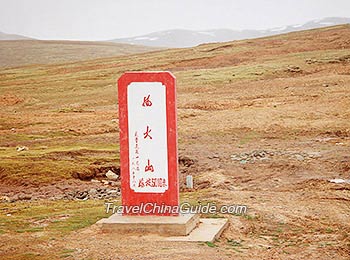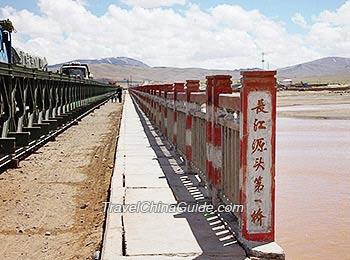Tibet Railway Construction
The Tibet Railway, sometimes referred to as the “Heavenly Road,” is being constructed in segments. The first section completed was to Xining and is a busy passenger line. The section from Xining to Golmud was completed in 1979 and put into use in 1984. The section from Golmud to Lhasa went into service since July 1, 2006. One of its three branches, the Lhasa- Shigatse Railway started operation on August 15, 2014; plans call for this branch to be extended for another 336 miles (540 kilometers) from Shigatse to Gyirong port, the border of China and Nepal, by 2020. The other two branches, Lhasa- Nyingchi and Shigatse-Yadong Railways are also scheduled to open by 2020.
As the railroad traverses through the world’s highest plateau (Qinghai-Tibet Plateau) and many complicated landforms, lots of challenges and difficulties were encountered during its construction, especially along the Xining-Lhasa section. The three major challenges were permafrost, a fragile ecological environment, and the lack of oxygen.
Permafrost - a mixture of soil and ice under 32 F (0 C) - expands in winter and contracts in summer. If the railroad is built upon this kind of soil, the bed sinks very easily. Different measures have been used in different sections to overcome this challenge: permafrost areas have been avoided if possible; bridges were built for the railroad bed on descending and ascending valley contours, and some new materials like heat transfer prevention planks were used to guarantee the stability of the railroad bed on the perennially frozen soil.
As the Qinghai-Tibet Plateau is the cradle of many rivers and home to lots of rare wild animals, protection of the local fragile ecological environment was the second challenge. In order to lessen the damage within Hoh Xil Nature Reserve and other nature reserves, the railroad circumvents these areas where possible to protect the Flora and Fauna. To guarantee the daily living and migration of the rare wild animals, 33 migration routes have been built including routes over tunnels for animals living in mountainous areas and underground passages for animals on the flatlands. To decrease the disturbance to the local environment, bridges have been built above the lakes instead of on the shoreline, the number of train stations has been greatly restricted, and effective sewage treatment measures have been adopted in both stations and trains along the way.
The third challenge, a lack of oxygen, threatened constructors’ lives. To solve this problem, 17 oxygen-generating stations and many clinics were built along the way. For passengers’ safety, the trains running along this line are equipped with oxygen generators.
There are a number of special architectural features, many of which broke Guinness World Records, along the section between Xining and Lhasa which allow animals to live as usual and trains to run smoothly and safely. Below is a list of the major ones.
 Nanshankou Trestle Base: Famous for advanced technologies and high trestle speed, the highest trestle speed was 7,191 yards (6,575 meters) a day, roughly the same as on flatlands.
Nanshankou Trestle Base: Famous for advanced technologies and high trestle speed, the highest trestle speed was 7,191 yards (6,575 meters) a day, roughly the same as on flatlands.
 Fenghuo Mountain Tunnel: Located in the hinterlands of the Tibet Plateau, 16,093 feet (4,905 meters) above sea level, it is the world’s highest rail tunnel. In addition, the whole tunnel, measuring 1,463 yards (1,338 meters) long, goes through a permafrost area. It took over 300 engineers and workers about one year to complete it.
Fenghuo Mountain Tunnel: Located in the hinterlands of the Tibet Plateau, 16,093 feet (4,905 meters) above sea level, it is the world’s highest rail tunnel. In addition, the whole tunnel, measuring 1,463 yards (1,338 meters) long, goes through a permafrost area. It took over 300 engineers and workers about one year to complete it.
 Tangula Railway Station: With an altitude of 16,627 feet (5,068 meters), this is the world’s highest train station. To make the permafrost under the station stable, the tracks were built on a unique rubble ventilation embankment.
Tangula Railway Station: With an altitude of 16,627 feet (5,068 meters), this is the world’s highest train station. To make the permafrost under the station stable, the tracks were built on a unique rubble ventilation embankment.
 Kunlun Mountain Tunnel: Measuring 1,844 yards (1,686 meters) long, this is the world’s longest tunnel through plateau permafrost areas. It took twice as long to build as on flatlands due to the low temperature and thin oxygen.
Kunlun Mountain Tunnel: Measuring 1,844 yards (1,686 meters) long, this is the world’s longest tunnel through plateau permafrost areas. It took twice as long to build as on flatlands due to the low temperature and thin oxygen.
 Qingshui River Bridge: Running through the sparsely populated Hoh Xil, the bridge was built to raise the railroad bed, so that animals can migrate via bridge openings. There are over 1,300 openings under this 11.7-kilometer-long (7.3 miles) bridge.
Qingshui River Bridge: Running through the sparsely populated Hoh Xil, the bridge was built to raise the railroad bed, so that animals can migrate via bridge openings. There are over 1,300 openings under this 11.7-kilometer-long (7.3 miles) bridge.
 Sanchahe Bridge: Passing over a deep valley, the bridge reaches a height of 177.5 feet (54.1 meters). It is supported by 20 piers, 17 of which are hollow and round, with the top only 11.8 inches (30 centimeters) thick. It has been a grand site along the way.
Sanchahe Bridge: Passing over a deep valley, the bridge reaches a height of 177.5 feet (54.1 meters). It is supported by 20 piers, 17 of which are hollow and round, with the top only 11.8 inches (30 centimeters) thick. It has been a grand site along the way.
 Yangtze River Origin Bridge: It is built in the Tuotuo River basin, the melting area of permafrost and and the origin of the Yangtze River. To protect the environment, the mud from the drilling was sunk into the riverbed rather than being thrown directly into the river and the building debris was moved to a designated site to be disposed of correctly.
Yangtze River Origin Bridge: It is built in the Tuotuo River basin, the melting area of permafrost and and the origin of the Yangtze River. To protect the environment, the mud from the drilling was sunk into the riverbed rather than being thrown directly into the river and the building debris was moved to a designated site to be disposed of correctly.
 Lhasa River Bridge: This is the final large bridge along the railroad. Its main piers resemble yak legs and the side piers are like snow lotuses, representing Tibetan fauna and flora. The three large arches are like three giant white Hada (a piece of silk used to welcome guests by Tibetan and Mongolian people), welcoming passengers. This bridge has become a Lhasa landmark and many tourists to the city come to see it.
Lhasa River Bridge: This is the final large bridge along the railroad. Its main piers resemble yak legs and the side piers are like snow lotuses, representing Tibetan fauna and flora. The three large arches are like three giant white Hada (a piece of silk used to welcome guests by Tibetan and Mongolian people), welcoming passengers. This bridge has become a Lhasa landmark and many tourists to the city come to see it.
Construction Challenges
Permafrost - a mixture of soil and ice under 32 F (0 C) - expands in winter and contracts in summer. If the railroad is built upon this kind of soil, the bed sinks very easily. Different measures have been used in different sections to overcome this challenge: permafrost areas have been avoided if possible; bridges were built for the railroad bed on descending and ascending valley contours, and some new materials like heat transfer prevention planks were used to guarantee the stability of the railroad bed on the perennially frozen soil.
As the Qinghai-Tibet Plateau is the cradle of many rivers and home to lots of rare wild animals, protection of the local fragile ecological environment was the second challenge. In order to lessen the damage within Hoh Xil Nature Reserve and other nature reserves, the railroad circumvents these areas where possible to protect the Flora and Fauna. To guarantee the daily living and migration of the rare wild animals, 33 migration routes have been built including routes over tunnels for animals living in mountainous areas and underground passages for animals on the flatlands. To decrease the disturbance to the local environment, bridges have been built above the lakes instead of on the shoreline, the number of train stations has been greatly restricted, and effective sewage treatment measures have been adopted in both stations and trains along the way.
The third challenge, a lack of oxygen, threatened constructors’ lives. To solve this problem, 17 oxygen-generating stations and many clinics were built along the way. For passengers’ safety, the trains running along this line are equipped with oxygen generators.
Famous Projects
 |
| Fenghuo Mountain |
 |
| Yangtze River Origin Bridge |
- Last updated on Apr. 10, 2019 -